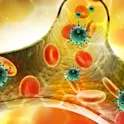
Impact analysis
05 Nov 2015
Quality and Impact Analysis: Frontiers in Neuroscience
By Pascal Rocha da Silva, Frontiers analyst The field of Frontiers in Neuroscience, established in 2008, has become the #1 most cited and #1 largest Open Access publisher of Neuroscience and the 3rd most cited and 4th largest Neuroscience publisher overall. The impact factor (IF), defined as the total number of citations divided by the number of citable articles over a two-year period, is the gold standard of journal quality (not of an individual scientist). It was formally established by the Institute for Scientific Information (ISI) in 1975. As the IF can be heavily skewed by a few highly cited papers, total citations generated over the same two-year period provide a more accurate measure of the overall influence or impact of the articles published by a journal in a field. Analysis within the JCR category of Neuroscience There are 252 journals listed within the category of “Neurosciences” in the 2014 Journal Citation Reports (JCR), provided by Thomson Reuters in 2015. There are 36 Gold Open Access journals indexed in the 2014 JCR. Frontiers is structured by academic fields (e.g. Neuroscience, Psychology, Plant Science, etc.) with specialty sections (e.g. Developmental Psychology). In the case of the field of Frontiers in Neuroscience, […]













